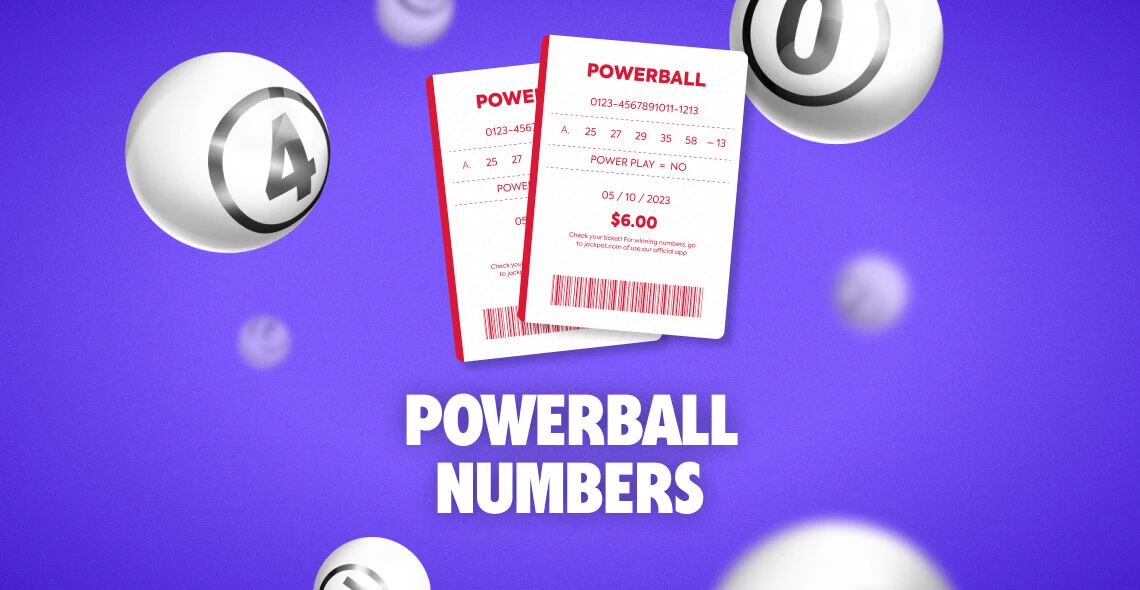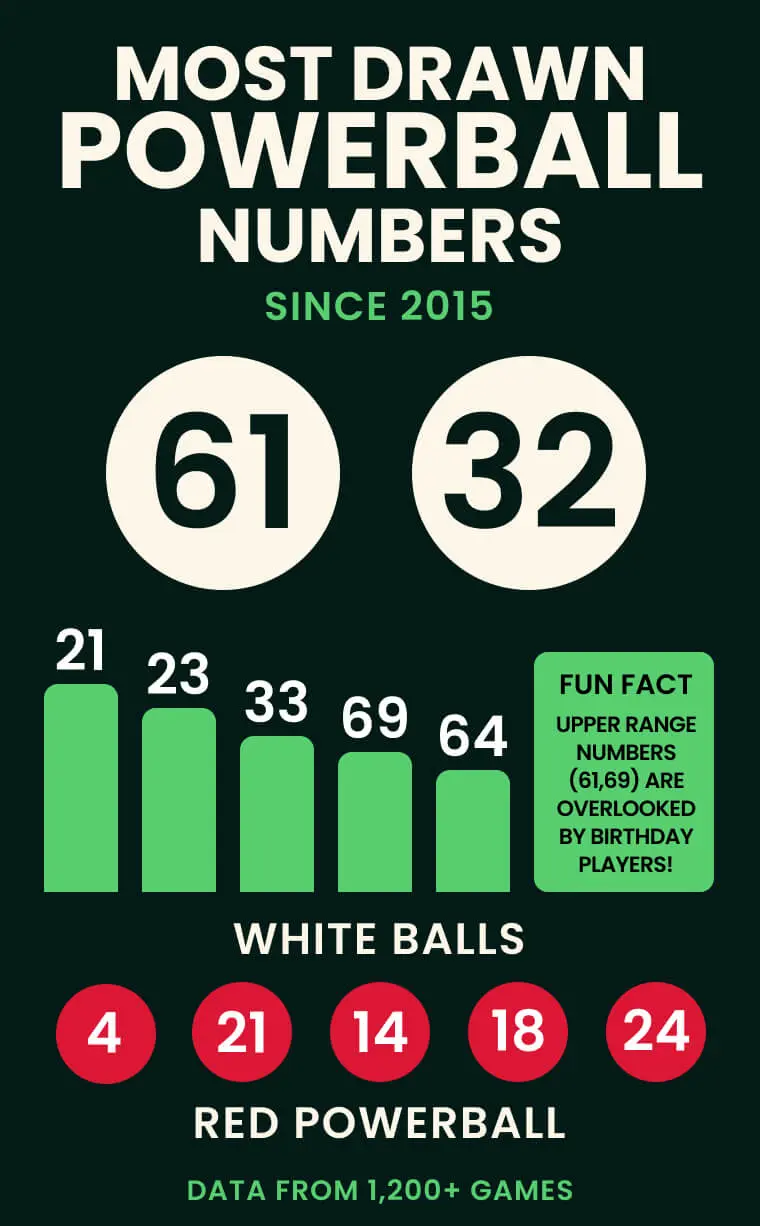The Most Drawn Powerball Numbers: Patterns, Strategies, and What They Really Mean
Written by Jackpot Staff
Updated: December 12, 2025

Have you ever stared at a Powerball playslip or the number grid online, wondering which numbers might boost your chances of winning that life-changing jackpot? You're not alone! Millions of lottery enthusiasts analyze past drawings, looking for patterns and "hot numbers" that might give them an edge in the next big draw.
Today, we're diving deep into the fascinating world of Powerball statistics to reveal which numbers have appeared most frequently over the years. While no strategy guarantees a win (it's still a game of chance, after all!), understanding these patterns can add an extra layer of fun to your lottery experience.
The Most Frequently Drawn Powerball White Ball Numbers

Based on analysis of over 1,200 Powerball drawings since the 2015 format change, certain numbers have shown up more frequently than others. Here are the top performers:
- 61 and 32: These numbers share the crown as the most frequently drawn, each appearing in approximately 9% of all drawings.
- 21 and 23: These high numbers have been drawn 112 times, making them a consistent performers.
- 33 and 69: These numbers round out the top six, each appearing in roughly 8.6% of drawings.
Other strong performers include 64, 27, 28, 62, 36, 39, 53, 63, 37, 44, 47, 3, 12, and 16 - all appearing in more than 100 drawings since 2015.
What's particularly interesting is that many players tend to choose numbers based on birthdays and anniversaries (1-31), potentially missing out on these high-performing numbers in the upper range like 61 and 69!
The Red Powerball Number Champions
When it comes to the crucial red Powerball (drawn from a separate pool of 26 numbers), these have been the most frequent visitors:
- 4: The undisputed champion, appearing in nearly 5% of all drawings.
- 21: This number has been drawn approximately 60 times.
- 14, 18 and 24: Completing the top five most frequent Powerball numbers.
Interestingly, the Powerball numbers tend to experience shorter "cold streaks" compared to the white balls. This makes sense mathematically - with only 26 possibilities versus 69 for the white balls, each Powerball number has a higher chance of being drawn in any given game.
How Powerball Has Evolved: Understanding the Numbers Game
To truly appreciate these statistics, it helps to understand how Powerball has changed over time. The game has undergone several format changes since its inception in 1992, with the most significant occurring in October 2015.
The 2015 reform expanded the white ball pool to 69 numbers (from 59) while reducing the Powerball pool to 26 (from 35). This dramatically changed the odds, making the jackpot harder to win (now 1 in 292.2 million) but increasing the chances of winning smaller prizes.
This format change essentially reset the frequency statistics, which is why our analysis focuses on drawings since late 2015. The current format gives us the most relevant data for today's Powerball players.
Hot vs. Cold Numbers: Should You Care?
Lottery enthusiasts often categorize numbers as "hot" (frequently drawn) or "cold" (rarely appearing). As of recent data:
Hot Numbers:
- White balls: 61, 32, 23, 21, 33, 69
- Powerball: 4, 21, 14, 18, 24, 25
Cold Numbers:
- White balls: 13, 49, 46, 26, 34, 25 (with 13 being the least drawn)
- Powerball: 16, 17, 15, 12, 7, 8 (experiencing the longest current droughts)
But here's the million-dollar question: Does a number's past performance actually influence its future appearances?
Statistically speaking, the answer is no. Each Powerball drawing is an independent event, meaning previous results don't influence future outcomes. The balls don't have memory! Number 13 might be "cold" with only 66 appearances, but mathematically, it still has exactly the same 1-in-69 chance of being drawn in the next game as the "hot" number 61.
Interesting Patterns and Combinations
Beyond individual numbers, some interesting patterns emerge when looking at combinations:
- Common Pairs: Some number pairs like 61/69, 21/32, 51/61, 37/44, 30/62, and 23/32 have appeared together multiple times.
- Consecutive Numbers: While rare, pairs like 66/67, 1/2, 61/62, 35/36, 21/22, and 17/18 have appeared together more often than pure chance would suggest.
- Even/Odd Balance: Winning combinations often feature a mix of even and odd numbers rather than all of one type.
Strategies for Picking Your Numbers
While no strategy can increase your odds of winning (each combination has exactly the same probability), here are some approaches to consider for a more enjoyable powerball experience:
1. The Balanced Approach
Consider selecting a mix of both "hot" and "cold" numbers. This gives you coverage across the spectrum while including some historically frequent performers.
2. Beyond Birthdays
Remember that nearly 40% of the white ball pool consists of numbers above 31. If you only play birthdays and anniversaries, you're missing out on numbers like 61 and 69 that have performed well historically.
3. Quick Picks Have Merit
Contrary to what some might believe, Quick Pick (randomly generated) tickets account for approximately 70% of Powerball jackpot wins. This makes sense considering the majority of tickets sold are Quick Picks!
4. Play Consistently
If you do choose specific numbers, consider playing them consistently. While this doesn't increase your odds of winning, it eliminates the possibility of "your numbers" winning when you didn't play them (talk about regret!).
The Reality Check: What These Statistics Really Mean
Here's the truth that every lottery player should understand: Powerball is designed to be random, and each drawing is independent of all previous results. The balls are carefully weighed, tested, and the drawing machines are regularly certified to ensure complete randomness.
So why do some numbers appear more frequently than others? Over a relatively small sample size (even 1,200+ drawings is small in statistical terms), random variation naturally creates some discrepancies. If we could observe millions of drawings, we'd likely see all numbers converge toward equal frequency.
Playing Powerball Responsibly with Jackpot.com
Whether you're fascinated by number statistics or just playing for fun, Jackpot.com offers a convenient way to participate in Powerball. Our online platform lets you:
- Order official Powerball tickets from your computer or smartphone
- Set up recurring orders so you never miss a drawing
- Receive automatic notifications if you win
- Access detailed statistics and historical drawing information
The best part? You're playing the exact same game, with the same odds and the same potential payouts as traditional retail purchases.
Informed Play is More Fun
While understanding the most frequently drawn Powerball numbers won't mathematically improve your odds of winning, it can certainly make your lottery experience more engaging and fun. After all, part of the enjoyment comes from the anticipation and the "what if" scenarios we create when selecting our numbers.
So what are you waiting for? Whether you choose to play the statistical favorites, your personal lucky numbers, or let the computer decide with a Quick Pick, the thrill of possibility remains the same. Just remember to play responsibly, viewing lottery tickets as entertainment rather than investment.
Ready to try your luck with some of these frequently drawn numbers? Visit Jackpot.com today to secure your tickets for the next Powerball drawing - and who knows? Maybe those hot numbers will work their magic for you!
* The hot and cold Powerball numbers referenced in this article are based on drawing data available through December 2025. Lottery results can vary, and past performance does not guarantee future outcomes. Always play responsibly.

